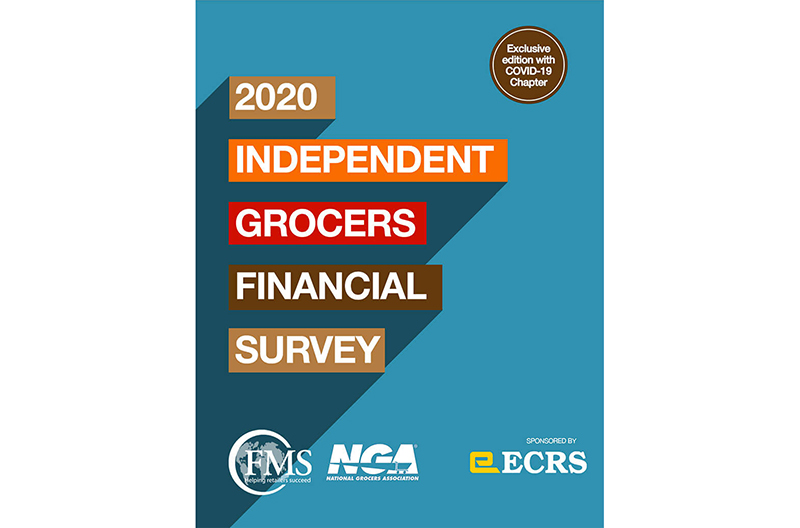The 2020 edition of the Independent Grocers Financial Survey, a joint study between the National Grocers Association and FMS Solutions, labels fiscal year 2019 as a solid year for independents.
“Independent grocers started to see positive trends pre-pandemic, which is a great sign of the strengthening,” said Robert Graybill, FMS CEO and president. “While the overall numbers were up, it was the profit leaders once again driving those increases. Their financial performance and operational execution served as a building block to respond to the extraordinary spikes in traffic, sales and engagement during the COVID-19 pandemic.”
Strong 2019 economy fueled financial success
The economy was strong in 2019, and low unemployment fueled consumer spending, including grocery shopping. Independent grocers increased same-store sales by 2.5 percent in 2019, with 56 percent improving same-store sales growth. Gains were slightly higher among multi-store operators. Close to four in 10 dollars were generated by perimeter departments, with an above-average contribution by fresh in larger volume stores.
Inventory management played big role
These robust gains were achieved based on higher inventory turns, at 18.7x for the total store, hand in hand with improved margins that reached 28 percent across departments. Many continued to focus on inventory management, accomplishing a reduction in total store shrink, at 2.9 percent, through the implementation of shrink management programs that focused on reporting, learning and correcting each week.
Labor market caused higher turnover
Independent grocers managed these sales gains amid rampant competition and a tight labor market. Employee turnover at independent retailers increased to 19.5 percent among full-time employees and 63.2 percent among part-timers. Yet, independents were better able to control personnel-related costs and the total labor and benefits expenses decreased somewhat to 15.7 percent of total 2019 sales. Additionally, reductions in rent, utility costs and a few other expense areas helped reduce total expenses slightly to 28.8 percent of total sales.
Rise in profits due to stellar performance among profit leaders
With increases in same-store sales and margins and a decrease in expenses, the net profit before taxes improved significantly, from +0.63 percent in 2018 to 1.05 percent in 2019. Behind the overall improvement in net profits, the study found that the independent marketplace grew more divided. The profit leaders, those in the 25th percentile in net profit performance, pulled away further. Their stellar performance improved the average profit across independents, whereas the bottom 75th percentile did not change.
Profit leaders averaged 5.3 percent net profit before taxes. Common traits among profit leaders include a high focus on fresh, particularly meat and produce, along with robust margin and expense management. The total store gross margin among profit leaders is 2.1 percentage points higher than that of the retailers in the bottom 75th percentile (“the pack”). Additionally, the leaders’ total expenses, excluding the costs of goods and labor, were more than 1.7 percentage points lower than the pack.
Reinvesting in stores, e-commerce crucial to pandemic success
Importantly, independents recognized the need for keeping stores fresh and therefore increased capital expenditures to 1.96 percent of sales. More than one-quarter of independents remodeled one or more stores in 2019. Independents also invested in e-commerce, which was offered by 64 percent of independents in 2019, up from 32 percent in 2018. Many offer both delivery and pickup (30 percent) or pickup only (26 percent). It was precisely this investment in the stores, marketing, advertising and e-commerce that allowed the independent community to welcome the surge of shoppers during the 2020 pandemic.
COVID-19 sales, changes among independent grocers
Coronavirus prompted two of the biggest weeks in grocery retailing in mid-March and elevated everyday demand has driven gains well above the 2019 base level ever since. While shoppers have been taking fewer trips, they spend more per visit, resulting in total store sales for independents being up 13.3 percent through the first half of 2020. Large contributors are frozen foods, center store, meat and produce.
COVID-19 brought along many changes and expenses for independent grocers as well.
These included:
- 100 percent bought additional disinfecting and cleaning supplies and 96 percent provided employees with masks.
- 84 percent purchased and installed plexiglass shields in one or more departments or frontend.
- 66 percent of independent grocers changed store hours for sanitation, senior/first responder hours, etc.
- 85 percent paid overtime expenses during the pandemic, with 71 percent citing a lack of available employees prompting overtime for those willing/available to work.
- 85 percent paid hero pay and other bonuses and incentives, but 93 percent were non-permanent changes.
“Alongside the important role in feeding America’s communities, the current pandemic has illustrated the agility and resiliency of independent grocers. As the supermarket industry continues to navigate these changes, independent grocers are in a unique position to find innovative and creative ways to better serve their customers,” said NGA President and CEO Greg Ferrara.

